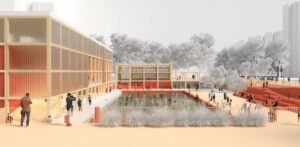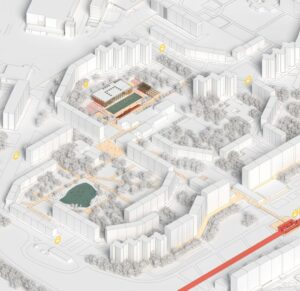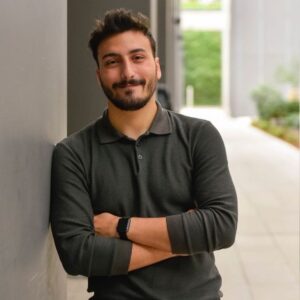Berk Kesimoglu
What has sparked your interest in participating in the ATELIER student competition?
The most important detail that caught my attention in the competition was undoubtedly the given topic. The idea of taking an energy production building that house a heat pump and creatively integrating it into the city excited me so much. Normally, we think of an energy production building as being located outside cities, far from public areas. The fact that we were asked to do the opposite made me question the current design decisions. The idea of not only generating energy but also bringing the community together and creating space for different activities also increased my interest in the competition. Lastly, the idea to combine the winning projects in a catalog, potentially serving as inspiration for future energy-positive cities, and the chance to participate in the World Architecture Congress were the things that convinced me that I absolutely had to participate in this competition.

For your concept, you could choose between Bratislava or Copenhagen as demonstration site. Based on which criteria did you make your choice?
I was visited both cities and I knew that each had its unique characteristics. During the preparation process for the competition and considering both the requirements of the competition and my own design ideas, I realized that Bratislava would be the best choice for me. Aspects such as city democracy and the citizen participation in decision-making processes were crucial for me, and I believed that this project would contribute to the development and progress of these two crucial things in Bratislava. Additionally, the specific design inputs of the project area, Petržalka, also attracted me to Bratislava. I thought that a project implemented here would best fulfill the goals of the competition while making significant contributions to the community and the city. Petržalka, where different segments of society coexist densely but do not come together enough, was the right area to achieve my objectives in a project that aimed to bring all segments of society together.
Where did you take inspiration for your idea?
Firstly, I examined the atelier project and its theoretical and practical applications. Then, I researched how similar technical buildings were designed around the world. At this point, I came across numerous examples that went beyond traditional design practices, and they guided me. In particular, the CopenHill building in Copenhagen served as a great example to me of how a technical building could come together with a different function and create a new landmark in the city. When I visited Copenhagen and saw this building, I witnessed how a technical building could blend with something entirely different. Moreover, my past works have certainly been helpful in terms of visual storytelling and idea generation. I utilized the knowledge I had built over the years in both visual representation and forming ideas.

What was the biggest challenge in coming up with an innovative concept?
For me, the biggest challenge was undoubtedly how to bring together a technical building with different functions. Furthermore, in my opinion, these different functions had to propose something different from the designs done so far. While solidifying the idea of coming together at a core space named debate hall, there were many other aspects to consider as well. Generating a data and transforming it to an information and giving it to society, cities, and even countries undoubtedly a significant challenge in this concept.
How can you see yourself benefitting from this task/experience for future projects/ concepts?
Instead of fitting a building to a single function and a specific definition, I will focus on researching and ensuring how it can be designed to better serve the community as a whole by integrating with the city. I will also be more sensitive to how the community actively participates and provides feedback in the design of a building and its surroundings. Considering the needs and expectations of the society, I want to design my projects as interactive and participatory spaces where the society can take a major role. In this way, my projects can become spaces that are embraced and owned by society. In my future projects, I want to focus on taking and designing a district as a whole and transforming it to offer more than single-functional build environments. When designing a building, I will consider not only the building, but also streets, parks, transportation systems, nature and society. By placing sustainability and environmentally friendly design principles at the center of my projects, I will consider environmental elements that will add value to the region. I will increase the livability of the region by integrating environmental and energy efficiency measures into my projects.

Are there any lessons learned in regard to creating a concept for multi-functional technical buildings?
I became aware that a building is much more than just a space or a collection of spaces; it is the actions and activities that take place within it and that is what define the building. Additionally, I realized the importance of heat pump technology in transitioning to sustainable and green energy. These buildings shape our future and enable us to live our daily lives. Instead of hiding these structures, we should highlight them and celebrate their existence. These buildings should be transformed into spaces that benefit neighborhoods, cities, people, researchers, scientists, in short, the entire community. Through this concept, I have acquired the consciousness that will enable me to achieve this in my future projects. I will also collaborate with stakeholders to encourage the active participation of the community and shape my projects with them. I will make my projects more inclusive and user-oriented, taking into account the ideas, feedback and needs of the community. I want to create spaces that can be integrated into the city and serve the society, by taking into account all the potentials and needs of a region, away from monotonous and limited functions. In this way, while designing structures that affect people’s daily lives, I aim to add value to the society and offer sustainable solutions for the future.
